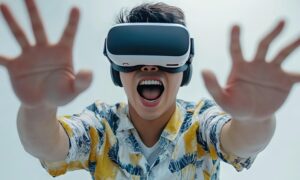Virtual Reality (VR) has come a long way from being a mere concept in the realm of science fiction to becoming an integral part of our everyday lives. The journey of VR has been one of innovation, technological advancements, and a growing realization of its potential. In this 1000-word blog post, we will explore the remarkable evolution of virtual reality, from its origins in science fiction to its current status as a transformative technology that has woven itself into our daily experiences.
The Birth of a Sci-Fi Dream
The concept of virtual reality first emerged as a sci-fi dream in the mid-20th century. Writers like Isaac Asimov and Philip K. Dick introduced readers to the idea of immersive, computer-generated environments that could transport people to entirely new worlds. However, it was not until the 1960s that the term “virtual reality” was coined. Computer scientist Ivan Sutherland is often credited with laying the foundation for VR with his creation of the first head-mounted display system called the “Sword of Damocles.” Although this early version was bulky and limited in its capabilities, it marked the beginning of VR as we know it.
The Rise of Virtual Reality in Research
During the 1970s and 1980s, VR began to find its place in academic research and military training. Universities and government agencies explored the potential of VR for training purposes, flight simulations, and even medical applications. These early efforts laid the groundwork for the development of more advanced VR technologies in the years to come.
The Gaming Revolution
The 1990s brought a significant breakthrough for virtual reality with the birth of consumer VR gaming. Companies like SEGA and Nintendo introduced VR peripherals that allowed gamers to step into immersive digital worlds. While these early attempts had their limitations and were often perceived as novelties, they piqued public interest in the possibilities of VR.
However, the hype eventually gave way to disappointment as the technology struggled to meet expectations. Hardware was expensive, and the experiences were often underwhelming. The result was a VR “winter” during the early 2000s when interest waned, and many companies shifted their focus away from VR.
The Rebirth of VR
Fast forward to the 2010s, and we witnessed the resurgence of VR. Technological advancements in areas such as computer processing power, graphics, and motion tracking breathed new life into the field. Oculus Rift, a company founded by Palmer Luckey and later acquired by Facebook (now Meta), played a pivotal role in rekindling interest in VR. Their headset, the Oculus Rift, offered a more immersive and affordable VR experience, opening the doors to independent developers and creating a community of VR enthusiasts.
Soon after, other major players like HTC Vive, PlayStation VR, and Microsoft’s Mixed Reality headsets entered the scene, further expanding the possibilities for VR gaming and applications.
Beyond Gaming: VR in the Real World
While VR gaming is undoubtedly a major driver of VR technology, its applications go far beyond the world of entertainment. VR has found its place in various industries, ranging from education and healthcare to architecture and automotive design.
In education, VR has revolutionized the way students learn by creating immersive, interactive experiences. History lessons can transport students to ancient civilizations, and science classes can take them on virtual field trips to the depths of the ocean or outer space.
In healthcare, VR is being used for pain management, rehabilitation, and medical training. Patients can escape the confines of their hospital rooms through VR experiences, and surgeons can practice complex procedures in a safe, virtual environment.
The architecture and automotive industries have also embraced VR for design and prototyping. Architects can walk clients through virtual renderings of their future buildings, and car manufacturers can test vehicle designs in VR before building physical prototypes.
VR in the Workplace
One of the most notable developments in the VR space is its integration into the workplace. Virtual meetings and collaboration have become commonplace, especially with the rise of remote work. VR enables colleagues from around the world to meet in a shared virtual space, fostering a sense of presence and enhancing teamwork.
Training and onboarding processes have also benefited from VR. New employees can receive hands-on training in a safe, virtual environment, while experienced workers can stay up-to-date with the latest developments through immersive, interactive learning experiences.
The Future of VR
As VR technology continues to evolve, we can only speculate about its future. However, some trends and possibilities are already emerging. The development of standalone VR headsets with built-in tracking and processing power is making VR more accessible and user-friendly. Augmented Reality (AR) and Mixed Reality (MR) are converging with VR, creating a spectrum of extended reality (XR) experiences that will further blur the lines between the digital and physical worlds.
Conclusion
From its humble beginnings as a science fiction concept to its integration into everyday life, the evolution of virtual reality has been nothing short of remarkable. With its applications spanning gaming, education, healthcare, and the workplace, VR has proven its transformative potential. As technology continues to advance, we can expect VR to become an even more integral part of our lives, enhancing how we learn, work, and play. The journey of virtual reality is far from over, and it promises to be an exciting one, as it continually pushes the boundaries of what’s possible in the digital realm. Virtual reality is no longer science fiction; it’s our everyday experience.



































